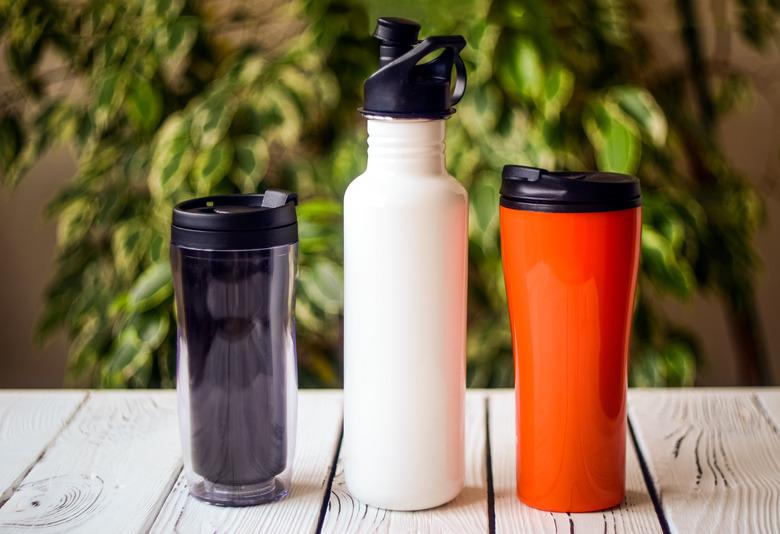How To Remove Mold From Plastic Drinking Bottles
We may receive a commission on purchases made from links.
Reusable water bottles may contain over 300,000 colony-forming bacteria units per square centimeter, according to a test by Treadmill Reviews. A pet toy, by comparison, has only 2,937. Though a plastic water bottle that you can use again and again is great for the environment, it may not be so great for your health. It's hard to see what's going on inside your bottle, and it may not be good.
Mold and bacteria love collecting on and in reusable drinking bottles, especially those with built-in straws and other nooks and crannies. Fortunately, you can prevent gross problems in your water bottle with proper cleaning. A soap and water wash every day coupled with an occasional heavier cleaning will keep your water clean and refreshing.
Daily Soap and Water
Daily Soap and Water
It's easy to skip the cleaning and just give your water bottle a quick rinse before refilling it. After all, it was only water in there. You've probably been guilty of this, but it's important to wash your bottle with soap and water every day, especially if you carry it with you often.
To do so, fill the bottle with warm water and a squirt of dish soap. Shake the bottle vigorously so the soap makes suds. Empty the bottle and then use a bottle brush to clean all the way to the bottom before rinsing. Remember to take the lid apart and clean all of its parts as well. You can also purchase straw brushes to clean out any built-in straws.
If it's safe to do so, run your water bottle through the dishwasher every few days. Place the bottle on the top rack along with the lid. If your lid comes apart far enough, you can also take it apart and wash it in the lidded silverware compartment.
Periodic Bottle Sanitizing
Periodic Bottle Sanitizing
A daily soap and water cleaning will do a nice job on your water bottle, but a bit of a deep cleaning every few days is also beneficial. About once every two weeks or if you notice mold in your water bottle, drop a teaspoon of baking soda and a teaspoon of bleach into your water bottle. Fill it the rest of the way with water and then shake it up.
Use a bit of the mixture to soak your water bottle lid components overnight. Let the remainder sit in the water bottle. In the morning, thoroughly rinse the water bottle and lid components and then reassemble the bottle.
White Distilled Vinegar
White Distilled Vinegar
Sometimes, water bottles can develop a bit of an odor, even with regular cleaning. To solve odor and mold problems, clean your water bottle thoroughly with soap and water. Next, fill the bottle with a mixture that is four parts water to one part distilled white vinegar. Let the vinegar mixture sit in the water bottle overnight and then rinse it thoroughly before using it.
Once again, it's important that you not neglect the lid. Take it apart as far as you can and soak it in the water and vinegar mixture overnight as well. Nooks and crannies in the lid can sometimes hold even more bacteria than the bottle itself.
Metal Water Bottles
Metal Water Bottles
It's a known fact that boiling water can kill bacteria, but using it on a plastic water bottle or plastic lid components isn't always an option. If you have a metal water bottle, however, filling it with boiling water is a simple way to help keep it clean. Just boil some water, fill the bottle, and allow it to sit for a few hours or overnight. Dump out the water when it's cooled down and you're ready to go.
Don't Reuse Disposable Bottles
Don't Reuse Disposable Bottles
It's worth mentioning that not all water bottles are intended for multiple uses. Disposable water bottles are meant for one use and one use only. Refilling them can start to break down the plastic, possibly exposing you to dangerous chemicals. You should avoid disposable bottles when you can. When you can't, make sure you dispose of or (preferably) recycle the bottle when you're finished.
References
- K-State Research and Extension: Your Reusable Water Bottle – Keep It Clean!
- Clemson Cooperative Extension: Healthy Living: The Scoop on Reusable Water Bottles
- Better Homes & Gardens: The Best Ways to Clean Reusable Water Bottles
- Ultra-Fresh: Black Mold in Your Water Bottle: How to Spot & Remove it
- Treadmill Reviews: A Look Under the Cap: Water Bottle Germs Revealed
- New York State Department of Health: Boil Water Response – Information for the Public Health Professional
